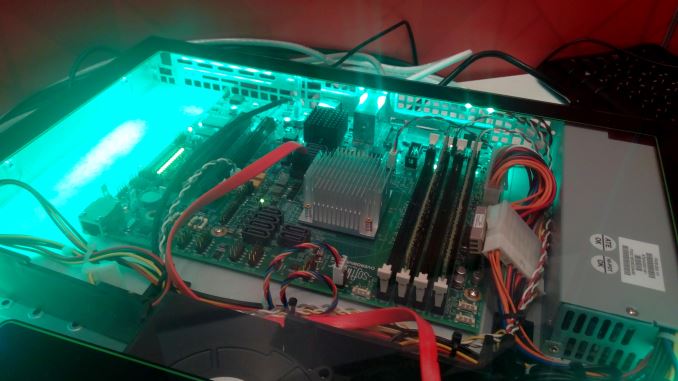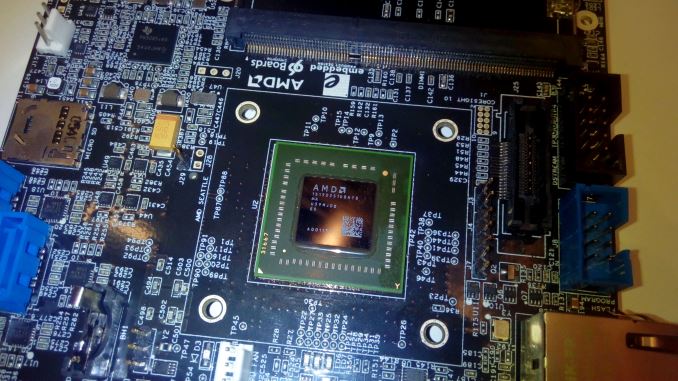ARM on AMD: The A1100 Seattle Silicon at SuperComputing 15
by Ian Cutress on November 24, 2015 7:30 AM EST- Posted in
- CPUs
- AMD
- Arm
- Opteron
- Trade Shows
- Opteron A1100
- Cortex A57
- ARMv8
- SC15
- Seattle

Anyone loosely following AMD’s efforts with ARM intellectual property would have had on their periphery the noise of the A1100 product aimed at servers, codenamed Seattle. The idea was to use AMD’s back-end expertise to produce a multi-core ARM chip based on eight A57 cores for server and professional embedded systems, supporting up to 128GB of RDIMM memory and two 10GBase-KR Ethernet ports. The secret sauce of the processor is in the co-processors – a cryptographic one to offload dedicated acceleration of encryption/decryption or compression/decompression, and a system control co-processor that focuses on security and acts like a ‘processor within a processor’ with its own Ethernet connection, RAM, ROM and IO connectivity for remote management and sensing.
The AMD A1100 – Steven’s piece last year goes into a lot more detail.
The chip was designed to be the ‘scale-out’ ARM part that Calxeda attempted to produce with Cortex A9’s, but only marginally edged out a dual-Xeon running virtual machines – the step up to a more powerful core was vital to attack this element of the industry. Despite Calxeda’s attempts at dense web-server traffic requests, AMD is focusing more on the data center where it feels this chip is more suited for. So even though there have been many delays with the hardware, missing its original time-to-market window by at least nine months, I finally got to see the silicon for my own eyes.
Starting with the platform it is in: this is the SoftIron Overdrive 3000. The silicon has access to eight SATA ports and eight PCIe lanes by default, along with a dual-channel memory controller, but what was interesting in this device was that there are six other SATA ports but no extra controllers. I quizzed the ARM personnel around the product and they said that a future chip might support more SATA ports, so this was almost a long-term drop-in PCB so for the second generation it doesn’t need a redesign. But this mini-server design is meant for that simple integration into a rack as an ARM development platform or connecting ARM to an accelerator/storage subsystem.
We also had the HuskyBoard from 96Boards on display, aimed at the embedded development market with the same A1100 silicon in the center but with access to a slot of memory on each side (one on the rear), various power options (seems like DC-In and Molex) and a full PCIe 3.0 x8 slot. This almost looks like one of the maker boards we commonly see with other ARM based solutions.
There we go, it exists! Speaking to other people in ARM, they are actually quite pleased that it is now in production, and they are also impressed with the internal metrics they are seeing from it. The march on ARM for server and embedded has been fraught with peril if you go too big too fast, but I wonder how many resources AMD is still putting into this project rather than their core business units.














18 Comments
View All Comments
bill.rookard - Tuesday, November 24, 2015 - link
That little Huskyboard is interesting. That could handle 3 SATA drives and work as a micro server. And since they make ECC SODIMMs and the A1100 should handle ECC RAM... You could fit several of those into a single 1U rack quite easily and have some pretty power-efficient performance.extide - Tuesday, November 24, 2015 - link
Yeah, that HuskyBoard looks awesome. Apparently you can't buy one yet, or at least I looked around for a while for a place to buy one but couldn't find anywhere. I definitely want one to play with, unless its just ridiculously expensive.BurntMyBacon - Tuesday, November 24, 2015 - link
I'd love to get a feel for the pricing on these. Seems like this chip could make a great little home built file server for the demanding enthusiast. Eight SATA ought to suffice for most. 10G ethernet is more than most home networks are capable of. Plenty of capacity for relatively high speed RAM makes for a nice sized ARC cache. Finally, the eight lightweight cores can be used for additional services (Domain, DLNA, etc) with no perceptible loss of performance from the file server proper.BurntMyBacon - Tuesday, November 24, 2015 - link
@Ian: "... , but I wonder how many resources AMD is still putting into this project rather than their core business units."I thought the whole reason this was late was that they retasked these engineers to work Zen. The engineers needed to work on this presumably finished their work on Zen and returned to complete this (different set of expertise working Zen now). If they can keep an alternating cadence with these two lines, I don't see any reason they can't work both without getting in each other's way. Good way to keep your engineers gainfully employed between designs as well.
CiccioB - Wednesday, November 25, 2015 - link
Is the PP known? 14nm or 16nm?CiccioB - Thursday, November 26, 2015 - link
Oh, now that I can see images I see that they are 28nm parts... we are still a step back to be just a single step back from the most advanced PP... it is clear that this piece of silicon cannot compete with anything.BlueBlazer - Thursday, November 26, 2015 - link
These boards and systems are for 'development' purposes thus not ready for real world retail products yet. Video of those boards and systems here https://www.youtube.com/watch?v=7k1EJaPRXsMtwotwotwo - Tuesday, December 1, 2015 - link
To imagine what the speed and price need to be to compete, compare with Xeon D--full-size (non-Atom) cores but cheap and lowish clocks, also with integrated 10gbE. The cheapest is 4C @ 2.4GHz, $200. By the time an A1100 or whatever ships Intel might've inched forward a bit more.http://www.anandtech.com/show/9185/intel-xeon-d-re... reviews it here
http://ark.intel.com/products/91202/Intel-Xeon-Pro... is the cheap one
At this point I imagine if ARM servers get much uptake it might be a giant existing maker like Qcom or Samsung deciding to throw some very-low-margin CPUs out there, or it's initiated on the purchaser side, i.e., development's effectively funded by one of the handful of companies with huge datacenters in hopes of saving on tasks that aren't CPU-bound today. But, on the flipside, those big purchasers are also good at optimizing use of the boxes they have and are well positioned to get good deals from Intel; they might not be that motivated to try and make ARM work.
Also imagine, somewhat more handwavily, that the fast ARM chips may still not have crossed over into the zone of "good enough" single-threaded performance for servers yet. Many apps are latency sensitive and built in a way that isn't totally light on the CPU. Like, you may want to run a Java or RubyPythonWhatever Web app on it and want it to feel reasonably snappy to the user. That needn't mean matching Intel's big cores for single-threaded speed, but it does mean finding the magical fast-enough line and getting across it.